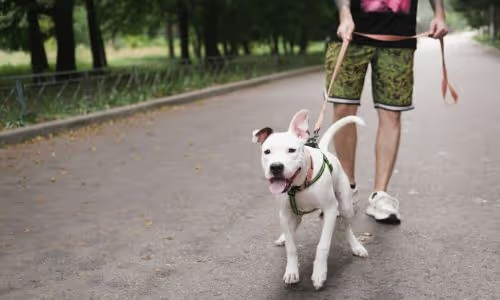Should your dog sit politely for petting? Should you allow interactions at all? Is it okay if they jump for affection from a new friend?
We're here to help you figure out how you'd like your dog—an individual with their own personality and preferences—to greet people in a way that works for everyone involved.
Some general things to keep in mind about greetings
- Not everyone out in public loves dogs. (That's okay.) Unless someone specifically asks to say hi to your pup, it's a good idea to give strangers space. Avoid letting your dog run right up to them or sniff their belongings.
- Saying hi on-leash can be complicated for some dogs. We've got a full blog on that here with more thoughts!

You might ask your dog to sit for petting if...
- They love affection from new people—they want everyone to be their best friend!—and might jump up if you don't give them clearer direction.
- They're confident and social, so you're not worried about them feeling trapped in an unwanted interaction.
- You're training for the Canine Good Citizen test, which includes sitting politely for petting as one of the test items.

You might not ask your dog to hold a command if...
- They have a tendency to feel trapped in situations and you want them to feel free to move away on their own.
- They're usually pretty calm meeting new friends, so you're not worried about them jumping up.
- You're in a situation—like introducing your pup to dog-loving friends of yours—where jumping up would actually be just fine!

What’s a Rich Text element?
The rich text element allows you to create and format headings, paragraphs, blockquotes, images, and video all in one place instead of having to add and format them individually. Just double-click and easily create content.

Static and dynamic content editing
Static and dynamic content editing
A rich text element can be used with static or dynamic content. For static content, just drop it into any page and begin editing. For dynamic content, add a rich text field to any collection and then connect a rich text element to that field in the settings panel. Voila!
How to customize formatting for each rich text
Headings, paragraphs, blockquotes, figures, images, and figure captions can all be styled after a class is added to the rich text element using the "When inside of" nested selector system.

You might instruct people to ignore your dog if...
- They really love new people and you're trying to work on training neutrality.
- They struggle to focus on you when someone new is around, so you're trying to make new people less exciting.
- They feel nervous around strangers and you don't want them to be overwhelmed—but you do want them to have exposure to being near new people.

You might avoid interactions altogether if...
- Your dog isn't comfortable with new people, and greetings aren't a personal priority for you.
- You're still working on training in controlled situations and don't think this particular interaction will be successful (either because your pup is excited or scared).
- You just want to be present in the moment with your dog.
It's okay to change it up!
There's nothing wrong with doing different things in different situations. Just make sure you're clear with your pup about when they are and aren't allowed to make new friends.
Some personal examples:
- We usually don't let people pet our blue heeler, Scout, because she's shy and can easily get overwhelmed if folks call her right over. If we're meeting up with trusted friends, though? They're welcome to invite her to them!
- Scout isn't allowed to jump up on anyone except me and Sean. We took time to teach her this in our early days together, initially having her wait for our invitation first (and redirecting her if she tried to put paws on anyone else).
- By default, we expect our dog to ignore new people. We spend a lot of time ou in public. It would be a huge hassle if she was constantly distracted!
- If she's allowed to approach, we give her a clear "okay" signal so she isn't confused about why we sometimes go in for sniffs and other times don't.
- My mom's therapy dog, Margo, loves new people. (That's why she's so good at her job.) My mom asks her to sit before people pet her, and she holds the position while they touch her. We'd never do this with Scout—but it's the perfect solution for a more social, confident pup!










.avif)